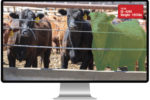Articles Tagged with ''stockmanship''
‘It was like magic': Low-stress cattle handling and not-to-miss tips
A key element of low-stress cattle handling is taking charge of things you can control when working cattle to make the experience safe and hassle-free.
Read More
Top 4 things you should look for in a manual cattle chute
Keeping some critical characteristics in mind when selecting a manual chute can help take the confusion out of the decision-making process.
Read More
Receiving high-risk cattle
High-risk cattle can be a gamble, and while health problems are inevitable, the impact can be reduced. Additionally, these cattle have the potential for high returns if you can minimize stress and keep the cost of gain low.
Read More
Across the Fence: Grunts, groans and guffaws, oh my!
Often, what isn't said is the best communication when working cows.
Read More
Evaluating stockmanship
An honest look at cattle-handling facilities and the people working them can yield major improvements in your operation’s ability to work cattle safely and efficiently.
Read More
Steps to halt zoonotic disease transmission
Some simple safety practices can help prevent the spread of zoonotic disease to feedlot workers.
Read More
The value of preconditioning calves
Learn about the health component of vaccines, dewormers and diets used in preconditioning calves. Value-added plans are available at many feedyards, sale barns, auctions, drug companies, breed associations and state programs.
Read More
Efficiency, precision and ethical beef production: The impact of 3D cameras
Frequent weighing of beef cattle is an integral part of the beef production process, and the utilization of 3D cameras for cattle weighing offers compelling advantages over traditional scales.
Read More







